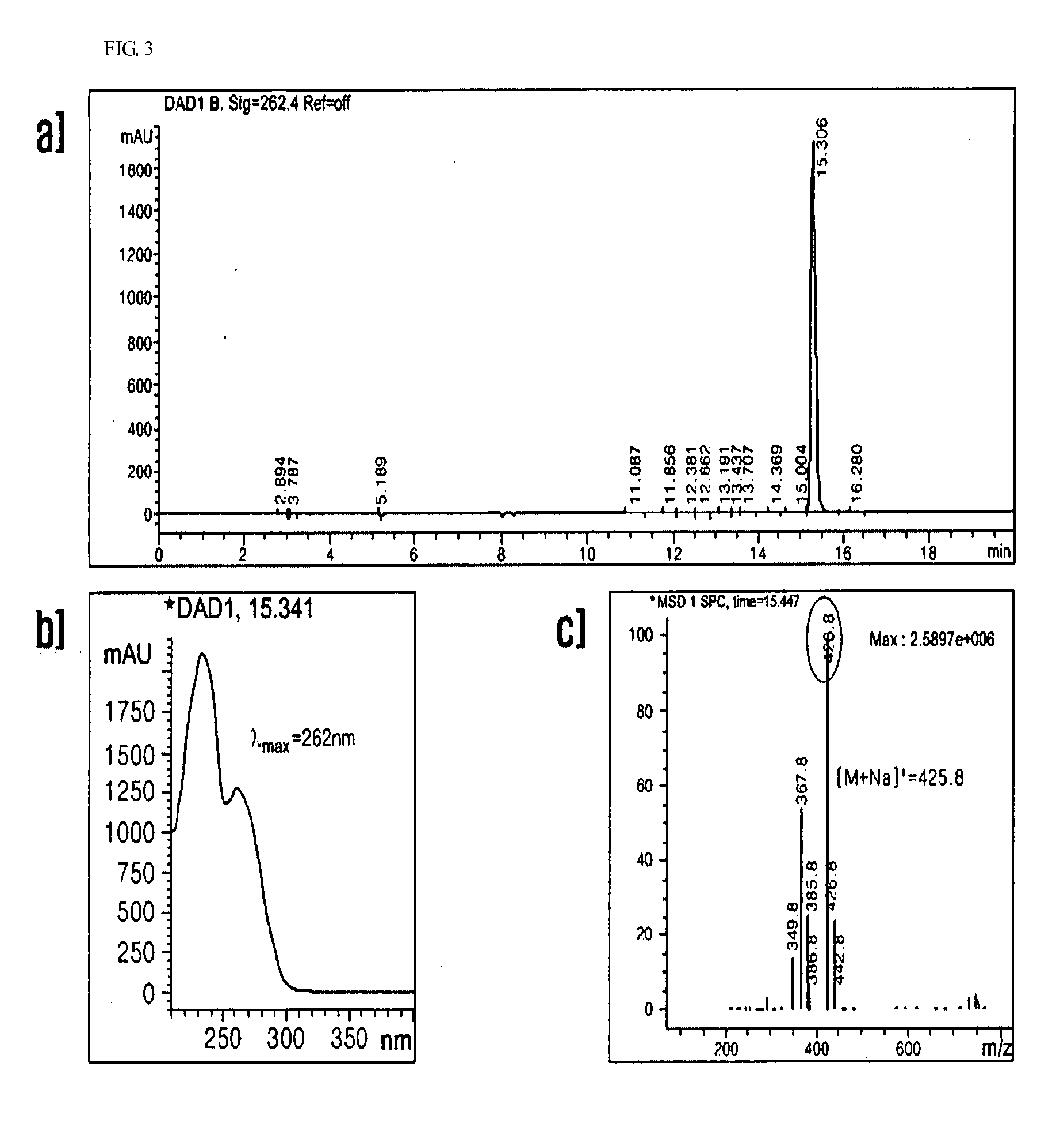Anti-inflammatory composition containing macrolactin a and a derivative thereof as active ingredients
a technology of macrolactin and active ingredients, applied in the field of anti-inflammatory compositions containing macrolactin and its derivatives, can solve the problems of considerable adverse effects of conventional anti-inflammatory agents
- Summary
- Abstract
- Description
- Claims
- Application Information
AI Technical Summary
Benefits of technology
Problems solved by technology
Method used
Image
Examples
example 2
Investigation of Anti-Inflammatory Activities of the Macrolactin Compounds on a Murine Macrophage RAW264.7 Cell Line
[0064]RAW264.7, a murine macrophage cell line, was obtained from Korean Cell Line Bank (KCLB). It was cultured in Dulvecco's modified Eagle's medium (DMEM, LONZA) containing 10% fetal bovine serum (FBS, LONZA) and 1% penicillin / streptomycin (Sigma) in an incubator at 37° C. under 5% CO2 and then sub-cultured when the cell density reached 80%. After RAW264.7 cells were cultured for 24 hours, MA (1-100 μM), MMA (10 μM), SMA (10 μM) and hydrocortisone (10 μM), which is a well-known substance having anti-inflammatory activity, were added. One hour after the addition, LPS (0.1 or 1.0 μg / ml, Sigma) was added to the mixture, which was then cultured for 8 or 16 hours. Dimethyl sulfoxide (hereinafter, “DMSO”) was used as a negative control, while LPS (0.1 or 1.0 μg / ml, Sigma) was used as a positive control without adding the macrolactin compounds.
experiment 1
ffect on NO Formation
[0065]NO concentration in cell culture was determined by using a Nitrate / Nitrite colorimetric assay Kit (Cayman). Murine macrophage RAW264.7 cells adjusted to 1×105 cells / well were cultured in a 6-well plate for 24 hours under the conditions mentioned in Example 2, and then further cultured for 16 hours after being treated with the present macrolactin compounds and LPS (0.1 μg / ml, Sigma). The cultured media were treated with Griess reagent R1 (sulfanilamide) and then Griess reagent R2 (N-(1-Naphthyl)-ethylenediamine) in a 96-well plate provided by the manufacturer, and then detected the formation of purple azo group from nitrite. The amount of produced NO was calculated using the calibration curve which had been made through the standard solution provided by the manufacturer at an absorbance of 540 nm in a UV spectrometer.
[0066]As a result, both MA and hydrocortisone strongly inhibited NO formation, while MMA and SMA showed low inhibition activities (see FIG. 6)...
experiment 2
ffect on PGE2 Formation
[0067]The amount of formed PGE2, an intracellular anti-inflammatory factor, was determined by using an Amersham prostaglandin E2 biotrak Enzymeimmunoassay (EIA) system Kit (GE Healthcare). Murine macrophage RAW264.7 cells adjusted to 2×104 cells / well were cultured in a 96-well plate for 24 hours under the conditions mentioned in Example 2 and then further cultured for 16 hours after being treated with the present macrolactin compounds and LPS (0.1 μg / ml, Sigma). The amount of produced PGE2 was calculated using the calibration curve which had been made through the standard solution provided by the manufacturer at an absorbance of 450 nm in a UV spectrometer. The r2 value of the calibration curve against the standard substance was above 0.99.
[0068]As a result, MA, MMA and SMA all strongly inhibited PGE2 formation, and the inhibition activities were similar to or comparable to that of hydrocortisone (see FIG. 7).
PUM
| Property | Measurement | Unit |
|---|---|---|
| pH | aaaaa | aaaaa |
| flow rate | aaaaa | aaaaa |
| particle size | aaaaa | aaaaa |
Abstract
Description
Claims
Application Information
 Login to View More
Login to View More - R&D
- Intellectual Property
- Life Sciences
- Materials
- Tech Scout
- Unparalleled Data Quality
- Higher Quality Content
- 60% Fewer Hallucinations
Browse by: Latest US Patents, China's latest patents, Technical Efficacy Thesaurus, Application Domain, Technology Topic, Popular Technical Reports.
© 2025 PatSnap. All rights reserved.Legal|Privacy policy|Modern Slavery Act Transparency Statement|Sitemap|About US| Contact US: help@patsnap.com



